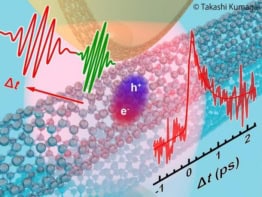An X-ray diffraction study of archaeological powders has shed light on the processes that ancient Egyptians used to make their characteristic black eye make-up. According to Tamas Ungár of the University of Budapest in Hungary and co-workers, the crystal structure of preserved lead-based cosmetics shows that crushing, sieving and even annealing were used to produce make-up four thousand years ago (T Ungár et al 2002 J. Appl. Phys. 91 2455).

The main ingredients of early cosmetics were lead sulphide and lead carbonate, the most common naturally occurring lead compounds. Lead sulphide – or ‘galena’ – is grey and relatively soft with a cubic crystal structure. Lead carbonate – or ‘cerussite’ – is white, harder than galena, and has an orthorhombic crystal structure.
In a study funded partly by cosmetics giant L’Oréal, Ungár and colleagues analysed 39 ancient lead-based cosmetic powders from the Louvre museum in Paris. Lead compounds strongly absorb X-rays, so the researchers used the powerful X-ray source at the European Synchrotron Radiation Facility in Grenoble, France, for their diffraction studies.
When X-rays enter a crystal, they are diffracted by the crystal lattice. The position of the peaks in the diffraction pattern reveals the spacing of the atoms in the crystal. Since the crystals in a powder are randomly oriented, X-ray diffraction leads to a wide range of diffraction angles. Ungár’s team were able to analyse these ‘peak profiles’ to reveal strain in the crystal lattices, which depends on the level of defects, such as dislocations.
By fitting their data to established models of crystallography, Ungár and co-workers also calculated the size of the crystallites, their size distribution and the density of dislocations in the samples. The team then compared these results with tests carried out on natural galena and cerussite, which they had processed in the lab.
Ungár and colleagues found that the ancient cosmetics were either dull or shiny, and that these were mixed in different proportions to vary the colour of the make-up. The dull powders had small crystals – between 130 and 240 nanometres across – with a high density of dislocations. Comparison with the artificial specimens suggested that these powders were ground for up to an hour. These fine powders were black with a matt texture.
The shiny powders contained crystals between 400 and 550 nanometres across, with a much lower dislocation density. This suggests that they were gently crushed then sieved to retain the larger crystallites, which had a high reflectivity.
Ungár’s team also found some evidence that ancient Egyptians heated lead compounds to create different coloured cosmetics. Lead sulphide oxidises upon heating, turning first yellow and then blue, but the samples were too small to confirm that this method was used.
“The Egyptians’ processes were not terribly sophisticated”, Ungár told PhysicsWeb. “They used grinding, sieving, and probably heating and annealing, but not at very high temperatures.”



